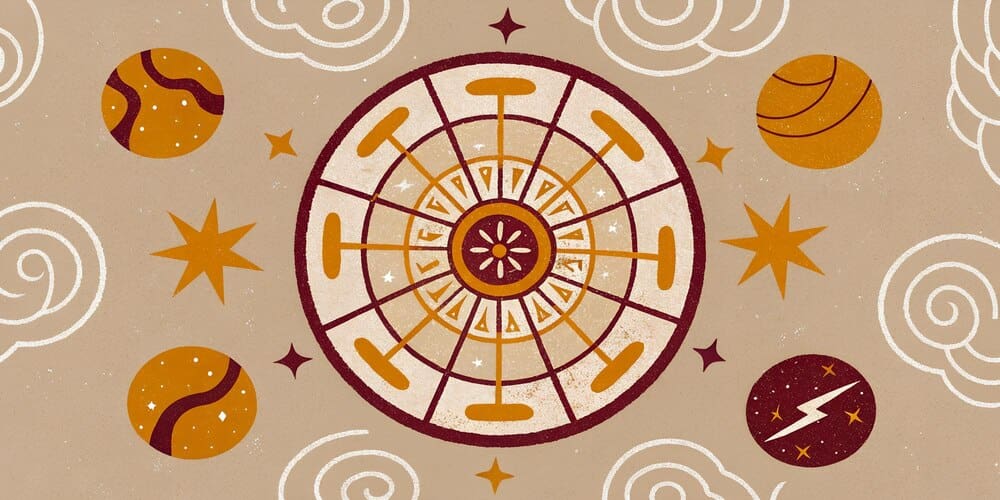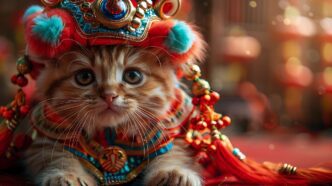KEY POINTS
- The Five Elements, or Wu Xing, are an ancient Chinese philosophical system that works with the zodiac to shape personality and the flow of universal energy.
- The five elements are Wood, Fire, Earth, Metal, and Water, each representing a phase in a cyclical process of growth, transformation, and control.
- These elements interact through two cycles—the Generating Cycle (supportive) and the Overcoming Cycle (restraining)—and your personal element is determined by the last digit of your birth year, providing deep insight into your innate strengths and weaknesses.
While many are familiar with the 12 animal signs of the Chinese Zodiac, a deeper and more nuanced layer of cosmic insight comes from the Five Elements—Wood, Fire, Earth, Metal, and Water. This ancient philosophical system, known as Wu Xing (五行), works in tandem with the zodiac to shape our personality, destiny, and the very flow of universal energy. It provides a dynamic framework for understanding not just who you are, but how you interact with the world, the people around you, and the specific energies of time itself.
The Five Elements are more than just static archetypes; they represent fundamental life forces and the phases of transformation. They are a core component of not only Chinese astrology (Bazi) but also traditional Chinese medicine, martial arts, and Feng Shui, illustrating the interconnectedness of all things. Understanding your personal element, and how it interacts with the elements of others and the current year, unlocks a profound level of self-awareness and guidance.
The Essence of Wu Xing: More Than Just Elements
The term Wu Xing is often translated as “Five Elements,” but a more accurate translation would be “Five Phases” or “Five Movements.” This distinction is critical because it highlights the system’s focus on cyclical change and interaction rather than static material substances. Each element represents a phase in a recurring cycle of growth, maturation, decline, and renewal.
These elements are not isolated. They exist in a constant state of flux, influencing one another through two primary cycles: the Generating Cycle, which promotes and nourishes, and the Overcoming Cycle, which controls and restrains. This cosmic dance of energies creates a system of checks and balances that governs everything from the changing of the seasons to the complexities of human relationships.
The Five Elements in Detail
Each element is associated with a vast web of interconnected concepts, including seasons, colors, directions, planets, and, most importantly for astrology, distinct personality traits. Discovering your dominant element offers a powerful key to understanding your innate strengths and weaknesses.
Wood (木, mù)
Associated with the season of spring and the direction of the East, Wood embodies the energy of growth, expansion, and new beginnings. Like a tree reaching for the sun, Wood personalities are driven by ambition, creativity, and a desire to build and achieve. They are often sociable, compassionate, and possess a strong sense of community.
People with a strong Wood element are natural leaders and visionaries. However, when out of balance, this expansive energy can manifest as impatience, anger, or a tendency to overcommit. Their challenge is to remain flexible, like bamboo, rather than rigid and brittle like a dead branch.
Fire (火, huǒ)
Fire corresponds to the peak of summer and the direction of the South. It is the element of pure passion, dynamism, and brilliance. Fire personalities are charismatic, enthusiastic, and often the life of the party. They are driven by a need for excitement, expression, and connection, drawing others in with their warmth and energy.
Their zest for life is contagious, but an excess of Fire can lead to burnout, drama, and impulsiveness. A lack of Fire, on the other hand, can result in a lack of joy or motivation. The key for Fire types is to channel their intense energy productively without letting it consume them or others.
Earth (土, tǔ)
Representing the center, stability, and the transitional period of late summer, Earth is the element of grounding, nourishment, and practicality. Earth personalities are the bedrock of any group—they are dependable, patient, and deeply nurturing. They provide a sense of security and are skilled at mediating conflicts.
Those strong in the Earth element are loyal and responsible, but can sometimes become stuck in a rut, resistant to change, or prone to worry. Their life lesson is to cultivate balance between stability and flow, providing support without becoming overly controlling or stagnant.
Metal (金, jīn)
Metal is linked to the season of autumn and the direction of the West. It symbolizes structure, discipline, and clarity. Metal personalities are organized, self-reliant, and possess a sharp intellect. They value order, justice, and precision, and they excel at cutting through confusion to get to the core of an issue.
While their focus and determination are admirable, an imbalance of Metal can lead to rigidity, aloofness, and excessive criticism of themselves and others. Metal types thrive when they learn to balance their need for structure with compassion and flexibility, embracing emotional expression as a strength.
Water (水, shuǐ)
Associated with the quiet introspection of winter and the direction of the North, Water is the element of wisdom, adaptability, and flow. Water personalities are deep thinkers, artists, and communicators. Like water itself, they can be both gentle and powerful, able to navigate obstacles with grace and persistence.
Their introspective nature gives them great insight, but it can also lead to secrecy, fear, or social withdrawal. The challenge for Water types is to trust their intuition and express their profound inner world, using their adaptability to connect with others rather than isolate themselves.
The Cycles of Interaction
The true power of the Five Elements system lies in understanding how the elements interact. These relationships determine compatibility, life challenges, and the energetic flavor of a particular day, month, or year.
The Generating Cycle (生, shēng)
Also known as the Creative or Mothering Cycle, this sequence describes how each element nourishes and gives rise to the next. It represents a harmonious and supportive flow of energy.
- Wood feeds Fire (burning wood creates fire).
- Fire creates Earth (ash from a fire becomes part of the earth).
- Earth bears Metal (metals and minerals are mined from the earth).
- Metal carries Water (metal vessels can hold water, or metal can attract condensation).
- Water nourishes Wood (water is essential for trees and plants to grow).
In relationships, individuals whose elements are in a generating sequence often feel a natural sense of support and understanding. A Wood person, for instance, may feel inspired and energized by a Water person’s wisdom and support.
The Overcoming Cycle (剋, kè)
Also known as the Destructive or Controlling Cycle, this sequence describes how each element controls or restrains another. While it sounds negative, this cycle is essential for creating balance and preventing any single energy from becoming too dominant.
- Wood parts Earth (tree roots break up the soil).
- Earth absorbs Water (dams and riverbanks contain water).
- Water extinguishes Fire.
- Fire melts Metal.
- Metal chops Wood (an axe can fell a tree).
This cycle can represent challenge and conflict in relationships. However, it can also provide necessary discipline. A Fire person’s impulsiveness might be tempered by a Water person’s calm, and a Wood person’s unbridled expansion might be given structure by a Metal person’s focus.
How to Find Your Element
In Chinese astrology, your primary element is determined by the last digit of your birth year. This system also incorporates the concept of Yin and Yang, with even years being Yang and odd years being Yin. Yang is associated with active, masculine energy, while Yin represents passive, feminine energy.
- If your birth year ends in 0, your element is Yang Metal.
- If your birth year ends in 1, your element is Yin Metal.
- If your birth year ends in 2, your element is Yang Water.
- If your birth year ends in 3, your element is Yin Water.
- If your birth year ends in 4, your element is Yang Wood.
- If your birth year ends in 5, your element is Yin Wood.
- If your birth year ends in 6, your element is Yang Fire.
- If your birth year ends in 7, your element is Yin Fire.
- If your birth year ends in 8, your element is Yang Earth.
- If your birth year ends in 9, your element is Yin Earth.
For example, a person born in 1986 has a Yang Fire element. Someone born in 1993 has a Yin Water element. This yearly element combines with the fixed element of your animal sign to create a more detailed and specific astrological profile.
A Deeper Cosmic Understanding
The Five Elements offer a profound and elegant system for making sense of the world and our place within it. They remind us that life is not static but a continuous flow of creation, control, and transformation. By understanding your own elemental nature, you can learn to harness your strengths, manage your weaknesses, and navigate your relationships with greater wisdom.
This ancient knowledge encourages us to seek balance—not just within ourselves, but in our interactions with the environment and the people we love. It is a timeless guide to living in harmony with the fundamental forces that shape our universe.








